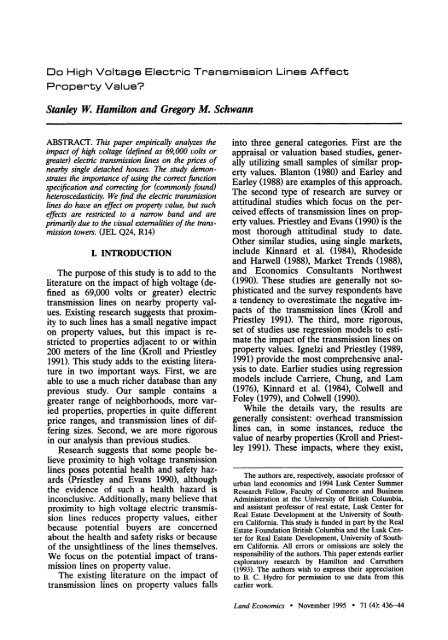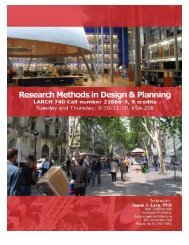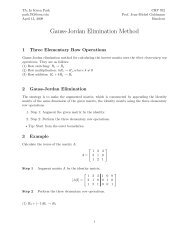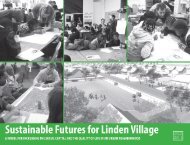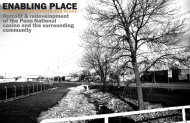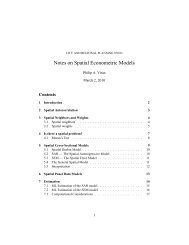Do High Voltage Electric Transmission Lines Affect Property Value?
Do High Voltage Electric Transmission Lines Affect Property Value?
Do High Voltage Electric Transmission Lines Affect Property Value?
Create successful ePaper yourself
Turn your PDF publications into a flip-book with our unique Google optimized e-Paper software.
<strong>Do</strong> <strong>High</strong> <strong>Voltage</strong> <strong>Electric</strong> <strong>Transmission</strong> <strong>Lines</strong> <strong>Affect</strong><br />
<strong>Property</strong> <strong>Value</strong><br />
Stanley W. Hamilton and Gregory M. Schwann<br />
ABSTRACT. This paper empirically analyzes the<br />
impact of high voltage (defined as 69,000 volts or<br />
greater) electric transmission lines on the prices of<br />
nearby single detached houses. The study demonstrates<br />
the importance of using the correct function<br />
specification and correcting for (commonly found)<br />
heteroscedasticity. We find the electric transmission<br />
lines do have an effect on property value, but such<br />
effects are restricted to a narrow band and are<br />
primarily due to the visual externalities of the transmission<br />
towers. (JEL Q24, R14)<br />
I. INTRODUCTION<br />
The purpose of this study is to add to the<br />
literature on the impact of high voltage (defined<br />
as 69,000 volts or greater) electric<br />
transmission lines on nearby property values.<br />
Existing research suggests that proximity<br />
to such lines has a small negative impact<br />
on property values, but this impact is restricted<br />
to properties adjacent to or within<br />
200 meters of the line (Kroll and Priestley<br />
1991). This study adds to the existing literature<br />
in two important ways. First, we are<br />
able to use a much richer database than any<br />
previous study. Our sample contains a<br />
greater range of neighborhoods, more varied<br />
properties, properties in quite different<br />
price ranges, and transmission lines of differing<br />
sizes. Second, we are more rigorous<br />
in our analysis than previous studies.<br />
Research suggests that some people believe<br />
proximity to high voltage transmission<br />
lines poses potential health and safety hazards<br />
(Priestley and Evans 1990), although<br />
the evidence of such a health hazard is<br />
inconclusive. Additionally, many believe that<br />
proximity to high voltage electric transmission<br />
lines reduces property values, either<br />
because potential buyers are concerned<br />
about the health and safety risks or because<br />
of the unsightliness of the lines themselves.<br />
We focus on the potential impact of transmission<br />
lines on property value.<br />
The existing literature on the impact of<br />
transmission lines on property values falls<br />
into three general categories. First are the<br />
appraisal or valuation based studies, generally<br />
utilizing small samples of similar property<br />
values. Blanton (1980) and Earley and<br />
Earley (1988) are examples of this approach.<br />
The second type of research are survey or<br />
attitudinal studies which focus on the per-<br />
ceived effects of transmission lines on property<br />
values. Priestley and Evans (1990) is the<br />
most thorough attitudinal study to date.<br />
Other similar studies, using single markets,<br />
include Kinnard et al. (1984), Rhodeside<br />
and Harwell (1988), Market Trends (1988),<br />
and Economics Consultants Northwest<br />
(1990). These studies are generally not sophisticated<br />
and the survey respondents have<br />
a tendency to overestimate the negative impacts<br />
of the transmission lines (Kroll and<br />
Priestley 1991). The third, more rigorous,<br />
set of studies use regression models to esti-<br />
mate the impact of the transmission lines on<br />
property values. Ignelzi and Priestley (1989,<br />
1991) provide the most comprehensive analysis<br />
to date. Earlier studies using regression<br />
models include Carriere, Chung, and Lam<br />
(1976), Kinnard et al. (1984), Colwell and<br />
Foley (1979), and Colwell (1990).<br />
While the details vary, the results are<br />
generally consistent: overhead transmission<br />
lines can, in some instances, reduce the<br />
value of nearby properties (Kroll and Priestley<br />
1991). These impacts, where they exist,<br />
The authors are, respectively, associate professor of<br />
urban land economics and 1994 Lusk Center Summer<br />
Research Fellow, Faculty of Commerce and Business<br />
Administration at the University of British Columbia,<br />
and assistant professor of real estate, Lusk Center for<br />
Real Estate Development at the University of Southern<br />
California. This study is funded in part by the Real<br />
Estate Foundation British Columbia and the Lusk Center<br />
for Real Estate Development, University of Southern<br />
California. All errors or omissions are solely the<br />
responsibility of the authors. This paper extends earlier<br />
exploratory research by Hamilton and Carruthers<br />
(1993). The authors wish to express their appreciation<br />
to B. C. Hydro for permission to use data from this<br />
earlier work.<br />
Land Economics * November 1995 * 71 (4): 436-44
71(4) Hamilton and Schwann: <strong>Property</strong> <strong>Value</strong> 437<br />
are generally less than 5 percent of the<br />
property value. The effects are confined to<br />
the immediate area of the transmission lines<br />
and dissipate quickly with distance. Neither<br />
the height of the transmission structures nor<br />
the voltage of the lines are found to have<br />
significant impact on property values. In all<br />
studies, other neighborhood factors dominate<br />
the explanation of variations in property<br />
values.<br />
Most studies involve properties which<br />
were sold after the transmission lines were<br />
in place, as does this study. In this case, the<br />
estimated impact of a transmission line on<br />
property values should be interpreted as a<br />
long-run equilibrium effect. When a new<br />
transmission line is constructed, or an old<br />
line extended in an existing subdivision, the<br />
measured effect will also have a dynamic<br />
component. Studies of transmission line extensions<br />
report that the impacts are initially<br />
significant, but quickly diminish over time<br />
(Kroll and Priestley 1991).<br />
In some studies a (small) positive impact<br />
is found. This is generally associated with a<br />
right-of-way (R-of-W) which is accessible for<br />
recreational use, or which is attractively<br />
landscaped, or provides added privacy to<br />
adjacent properties (Rhodeside and Harwell<br />
1988). However, the value of greenspace<br />
should not be overrated. Peiser and Schwann<br />
(1993) report that pure greenspace exerts a<br />
very small effect on property values.<br />
II. DATA<br />
The data used for this study includes all<br />
arms-length sales of single detached<br />
dwellings in four separate neighborhoods in<br />
the metropolitan Vancouver area' over the<br />
period 1985-91. The four neighborhoods are<br />
in proximity to existing transmission lines<br />
and the time frame corresponds to a relatively<br />
stable period in the market place. The<br />
rights-of-ways in the four areas include two<br />
areas with a 140m corridor with two 500kV<br />
and one 230kV lines on steel towers; one<br />
area with two transmission lines on steel<br />
towers; and one area with a 60kV line on<br />
wood poles. Each property in our sample<br />
was located on a map and the distance to<br />
the center of the transmission line right-of-<br />
way was recorded (DIS). Properties which<br />
were adjacent to the right-of-way were noted<br />
with a dummy variable (ADJACENT), and<br />
if a property was partially within the rightof-way,<br />
this was noted as a dummy variable<br />
(WITHIN). All properties within a 200m<br />
band2 of the transmission line were inspected<br />
to determine the number of towers<br />
(TOWERS) which were visible from the<br />
property and to determine if the transmission<br />
lines were visible (VISIBLE).<br />
Where necessary, the impact of vendor<br />
financing was removed from those sales<br />
prices involving vendor-supplied financing.<br />
Accurate and current property characteristics<br />
were then obtained for all properties<br />
sold within the time period of our sample.<br />
The property characteristics used in the<br />
analysis include the types of variables commonly<br />
found in the analysis of real property<br />
prices. Dummy variables were used for the<br />
presence of a GARAGE, POOL, SEWER,<br />
CURB, and CORNER lot. Continuous variables<br />
are used for the AGE of the dwelling,<br />
number of fireplaces (FIREPL), basement<br />
rooms (BASRMS), bedrooms (BEDRMS),<br />
full baths (FBATHS) and partial bathrooms<br />
(PBATHS), number of other rooms<br />
(OTHRMS), and the width (WIDE) and<br />
depth (DEEP) of the lot.<br />
The final sample included 12,907 transactions<br />
of single detached dwellings in the<br />
four study areas (Table 1). Of this sample,<br />
2,364 were within 200m of the transmission<br />
line and of these, 426 were adjacent to or<br />
partially within the right-of-way.<br />
III. FUNCTIONAL SPECIFICATION<br />
The question we address in this section is<br />
whether the simple linear or log-linear func-<br />
1<br />
British Columbia uses a Torrens system of land<br />
registration in which all sales must be recorded in a<br />
central registry and the market value or sales price<br />
reported. Analysis of the reported sales prices indicates<br />
they are accurately reported. The sales data used in<br />
this study were supplied by the provincial Assessment<br />
Authority. As part of their annual real property tax<br />
assessment function, they identified non-arms-length<br />
sales (e.g., sales between family members at less than<br />
full price).<br />
2 Previous studies report that 200m is the outer<br />
bound for the region affected by the transmission lines.
438 Land Economics November 1995<br />
TABLE 1<br />
SAMPLE SIZE AND SAMPLING AREAS OF<br />
PROPERTY TRANSACTIONS<br />
Total Within Adjacent<br />
Study Subarea Sample 200m to R-of-W<br />
Cloverdale 2,605 318 58<br />
Newton East-west 4,086 235 40<br />
Newton North-south 3,815 961 166<br />
Walnut Grove 2,401 850 162<br />
All Areas 12,907 2,364 426<br />
TABLE 2<br />
TESTS FOR FUNCTIONAL FORM<br />
Dependent Variable<br />
v,t<br />
In v,t<br />
Test Statistic Prob. Statistic Prob.<br />
J-test 25.832 0.0000 22.546 0.0000<br />
Quadratic 43.651 0.0001 42.933 0.0001<br />
Terms = 0<br />
Cross-product 13.489 0.0001 12.463 0.0001<br />
Terms = 0<br />
tional forms used by other authors provide<br />
an adequate approximation of the function<br />
relating house prices to property characteristics<br />
or whether more comprehensive functional<br />
specifications are needed. All of our<br />
test results are presented in Table 2.<br />
We begin by using MacKinnon's J-test to<br />
test the null hypothesis that the hedonic<br />
form is linear against the alternative hypothesis<br />
that the hedonic form is log-linear.<br />
This is a two-step test. In the first step, we<br />
estimate the log-linear model and calculate<br />
the predicted values from the regression. In<br />
the second step, the linear model is estimated,<br />
with the predicted values from the<br />
first regression included as an extra regressor.<br />
The t-statistic for the predicted values<br />
is the test statistic for the J-test. Our t-statistic<br />
for this test is 25.8 (Table 2, column 2);<br />
clearly, we can reject the null hypothesis of<br />
a linear functional form. The analogous test<br />
of a log-linear functional form against a<br />
linear functional form yields a t-statistic of<br />
22.5 (Table 2, column 3). Again, we can<br />
reject the null. Our results for this pair of<br />
tests show that neither the linear nor loglinear<br />
functional forms are up to the task of<br />
approximating the functional form for the<br />
hedonic relationship.<br />
We next consider approximating the hedonic<br />
function using a flexible functional<br />
form. After exploring the data by fitting a<br />
number of Box-Cox, Box-Tidwell, and spline<br />
regressions (not reported), we chose the<br />
translog functional form as our basic estimating<br />
equation. Our explorations showed<br />
that the general curvature of the hedonic<br />
function was best captured by a form which<br />
was logarithmic in the independent variables3<br />
and with price as the dependent variable.<br />
We later address the functional form<br />
of the dependent variable.<br />
It is well known that all flexible functional<br />
forms provide second-order differential<br />
approximations to an arbitrary function.<br />
However, in our past works, we have found<br />
that flexible forms suffer from multicollinearity.<br />
That is, the number of regressors<br />
might be reduced without severely compromising<br />
the fit. To examine whether this<br />
is true for our data, we estimate three<br />
translog functions of increasing complexity.<br />
Each of the three equations use logarithmic<br />
independent variables. The first includes<br />
only linear terms; the second includes linear<br />
and quadratic terms; and the third includes<br />
linear, quadratic, and cross-product terms.<br />
We test whether each increase in complexity<br />
is warranted using a standard Wald test.<br />
We first test whether the coefficients on<br />
the quadratic terms added to the linear<br />
specification are jointly zero. The value of<br />
the F-test of this hypothesis is 43.6 when<br />
the dependent variable is vi,, and 42.9 when<br />
the dependent variable is In vit (Table 2,<br />
columns 2 and 3). Obviously, the null hypothesis<br />
is rejected. Next, we add the crossproducts<br />
to each regression and test whether<br />
the coefficients on the cross-product terms<br />
are jointly zero. The F-test statistics are<br />
13.4 and 12.4, respectively, for the two de-<br />
3 Flexible functional forms are usually chosen because<br />
of desirable global curvature properties in demand<br />
or supply systems, or because of the domain of<br />
the independent variables. Since theory provides no<br />
guidance regarding the functional form for hedonic<br />
regressions, no such criteria operate here.
71(4) Hamilton and Schwann: <strong>Property</strong> <strong>Value</strong> 439<br />
pendent variables. The null is rejected in<br />
both cases. Thus, despite our concern about<br />
becoming overly complex, the test results<br />
indicate that the full translog specification is<br />
warranted.<br />
We now examine the appropriate transformation<br />
for the dependent variable conditional<br />
on a full translog specification of the<br />
independent variables. We fit a simple Box-<br />
Cox regression and estimate the power<br />
transformation by maximum likelihood. The<br />
estimated coefficient is .106 with a t-statistic<br />
of 8.4. Hence, the dependent variable is<br />
close to logarithmic in absolute terms, but<br />
not close enough to be statistically indistinguishable<br />
from zero.<br />
Unfortunately, residual diagnostics reveal<br />
that the regressions have a significant degree<br />
of heteroscedasticity. We test the homoscedasticity<br />
of the two regressions using<br />
the statistic proposed by Harvey (1974). The<br />
test values are 14,192.5 and 1,609.8 for the<br />
Box-Cox and log dependent variable regressions,<br />
respectively, and the values are both<br />
X2 distributed with 224 degrees of freedom.<br />
The null hypothesis of homoscedasticity is<br />
rejected.<br />
Based on the preceeding tests, we conclude<br />
that the curvature of the function can<br />
best be approximated using the following<br />
functional form:<br />
Y) =<br />
n n i<br />
+ E + tZit,<br />
0<br />
i=1 i=1j=1<br />
m 28<br />
+<br />
E aidi, + E<br />
i=1 t=1 aQi,<br />
PijzitZjt<br />
[1]<br />
where v) = (vi - 1)/0 is the Box-Cox<br />
transformed dependent variable, zi, are<br />
continuously measured dwelling unit characteristics,<br />
dit are discretely measured<br />
dwelling unit characteristics, and Qit are<br />
quarterly dummy variables for the date of<br />
sale. We deal with the problem of homoscedasticity<br />
by estimating the Box-Cox<br />
model with endogenous multiplicative heteroscedasticity.<br />
The log of the variance is<br />
taken to be linear in the unit characteristics.<br />
The estimations are done by maximum like-<br />
TABLE 3<br />
CORRECTED TESTS FOR FUNCTIONAL FORM<br />
Adjacent Mid-Range Far<br />
Properties Properties Properties<br />
X2 df X2 df X2 df<br />
Adding Quadratic 30.6 11 120.6 11 530.3 9<br />
Terms<br />
Adding Cross 154.8 52 207.5 57 663.5 38<br />
Product Terms<br />
AUll Terms 185.4 68 328.1 68 1,194.3 47<br />
TABLE 4<br />
TESTS FOR FUNCTIONAL HOMOGENEITY<br />
2<br />
Adjacent and Mid-Range 329.5 130<br />
Adjacent, Mid-Range, and Far 766.4 234<br />
lihood. We then apply equation [1] to the<br />
entire sample and examine the residuals.<br />
The residuals from equation [1] indicate<br />
that the hedonic functional form for properties<br />
adjacent to the high voltage electric<br />
transmission lines may be different from<br />
that for properties further removed from<br />
the lines. We examine this by dividing the<br />
sample into three sets of properties: properties<br />
adjacent to a transmission line (Adjacent),<br />
properties within 200m of a transmission<br />
line, but not adjacent to a line<br />
(Mid-Range), and properties more than<br />
200m from a transmission line (Far), and<br />
test for the equality of the coefficients of<br />
the hedonic regression across the subsamples.<br />
In Table 3, we report the likelihood ratio<br />
tests of functional specification for our three<br />
distance zones. The x2 statistics are all significant<br />
at a p-value of 0.001 or less. Thus, a<br />
full translog specification is strongly validated,<br />
even after the incorporation of a<br />
Box-Cox dependent variable and correcting<br />
for heteroscedasticity.<br />
In Table 4, we present the tests for a<br />
common functional relationship across the<br />
three distance zones in our sample. These<br />
tests are based on the full Box-Cox/trans-<br />
log functional form. The null hypothesis that<br />
the Adjacent and Mid-Range properties<br />
df
TABLE 5<br />
HEDONIC REGRESSION RESULTS<br />
Adjacent Mid-Range Far Adjacent M<br />
Properties Properties Properties Properties P<br />
Parameter Coeff. t-stat Coeff. t-stat Coeff. t-stat Parameter Coeff. t-stat Coef<br />
LAGE - 1.057 -0.806 -0.068 -0.153 0.141 1.173 LBEDLPBA 1.171 2.254 -0.10<br />
LFIREPL - 1.270 -0.567 - 1.940 - 1.752 -0.050 -0.197 LBEDLWID 5.107 1.921 -0.427<br />
LBASRMS 5.238 1.563 1.245 1.978 0.845 4.717 LBEDLDEE - 0.227 -0.238 -0.138<br />
LOTHRMS 8.182 1.958 -2.970 - 1.304 - 1.344 -2.595 LBEDLLDI -0.076 -0.257 -0.227<br />
LBEDRMS - 11.935 - 1.497 3.163 1.770 -0.713 - 1.305 LBEDLTOW -0.269 -0.712 -0.154<br />
LFBATHS -0.173 - 0.030 - 5.694 - 2.304 1.773 2.559 LFBALPBA 1.806 1.726 0.53<br />
LPBA THS 0.826 0.326 - 1.710 - 1.749 0.107 0.369 LFBALWID 0.965 0.697 0.56<br />
LWIDE - 10.755 - 1.799 -0.980 -0.552 - 1.072 - 2.973 LFBALDEE - 1.936 - 1.351 0.08<br />
LDEEP 5.252 0.745 -0.139 -0.053 -0.742 - 1.383 LFBALLDI 0.077 0.308 0.64<br />
LLDIS - 2.019 - 2.139 -0.059 - 0.070 LFBALTOW 1.335 1.828 0.33<br />
LTOWER 2.447 0.940 - 1.203 - 1.918 LPBALWID 0.582 0.960 0.24<br />
LAGELAGE -0.087 - 1.627 -0.062 -4.688 -0.051 - 15.151 LPBALDEE -0.937 - 1.245 0.14<br />
LFIRLFIR -0.092 0.794 0.018 0.273 0.092 4.878 LPBALLDI -0.019 -0.252 0.1<br />
LBASLBAS 0.133 1.989 0.052 1.479 -0.020 - 1.907 LPBALTOW 0.333 1.665 0.0<br />
LOTHLOTH 0.930 1.643 0.288 1.530 0.024 0.536 LWIDLDEE 1.052 1.494 0.0<br />
LBEDLBED - 1.864 - 2.197 0.024 0.265 0.022 0.797 LWIDLLDI 0.029 0.213 0.12<br />
LFBALFBA 2.604 1.636 0.669 3.649 0.540 11.489 LWIDLTOW -0.837 - 2.099 0.25<br />
LPBALPBA -0.024 - 0.115 0.138 1.743 0.129 5.420 LDEELLDI 0.318 1.846 - 0.11<br />
LWIDLWID - 0.103 - 0.507 -0.074 -0.632 -0.072 -2.126 LDEELTOW 0.187 0.553 0.05<br />
LDEELDEE -0.756 - 0.936 -0.068 - 0.288 -0.019 -0.360 LLDILTOW 0.063 1.151 0.02<br />
LLDILLD I 0.035 1.870 0.072 2.923 GARAGE 0.092 2.311 0.0<br />
LTOWLTOW 0.074 1.172 -0.024 - 1.428 SEWER -2.064 - 1.260 0.22<br />
LAGELFIR -0.041 -0.612 -0.004 -0.142 -0.049 -4.979 CURB 0.281 1.582 0.0<br />
LAGELBAS -0.123 - 1.576 -0.011 -0.670 0.033 6.121 SIDEWALK -0.179 - 1.205 0.0<br />
LAGELOTH -0.538 - 1.805 -0.122 -2.001 -0.079 -4.589 CORNER -0.045 -0.928 -0.01
LAGELBED 0.181 0.830 0.160 2.825 0.024 1.322 ENCUMB -0.151 -0.853 -0.02<br />
LAGELFBA 0.175 0.542 -0.173 - 2.399 -0.076 - 3.880 VISIBLE 0.210 0.888 -0.05<br />
LAGELPBA 0.122 1.028 -0.065 - 2.300 -0.053 -4.843 Q2 -0.156 - 1.560 -0.06<br />
LAGELWID 0.283 1.324 -0.037 -0.680 0.021 1.077 Q3 0.021 0.268 -0.04<br />
LAGELDEE 0.120 0.660 0.138 1.802 0.009 0.443 Q4 -0.019 -0.465 0.0<br />
LAGELLDI -0.042 - 1.631 -0.034 - 1.590 Q5 -0.035 -0.713 0.0<br />
LAGELTOW 0.081 0.924 -0.024 - 1.692 Q6 0.233 2.347 0.0<br />
LFIRLBAS 0.048 0.569 -0.005 -0.142 -0.003 -0.245 Q7 0.144 1.993 0.1<br />
LFIRLOTH -0.227 -0.951 0.458 2.913 0.028 0.772 Q8 0.263 2.162 0.1<br />
LFIRLBED -0.904 - 2.168 0.145 1.081 -0.069 - 1.790 Q9 0.523 2.589 0.1<br />
LFIRLFBA 0.657 1.514 - 0.027 - 0.157 0.088 1.789 Q10 0.367 2.585 0.2<br />
LFIRLPBA -0.010 -0.074 - 0.095 - 1.241 - 0.016 -0.781 Q11 0.296 2.312 0.2<br />
LFIRLWID 0.544 1.483 0.246 2.053 0.043 1.030 Q12 0.307 2.188 0.3<br />
LFIRLDEE 0.058 0.137 0.121 0.667 0.001 0.027 Q13 0.337 2.352 0.2<br />
LFIRLLDI 0.095 1.122 -0.077 - 1.246 Q14 0.332 2.317 0.3<br />
LFIRLTOW -0.052 -0.560 -0.010 -0.260 Q15 0.553 2.658 0.4<br />
LBASLOTH 0.034 0.188 -0.073 -0.833 0.008 0.334 Q16 0.507 1.869 0.6<br />
LBASLBED -0.366 - 1.439 -0.057 -0.715 -0.074 - 3.163 Q17 0.546 2.609 0.67<br />
LBASLFBA -0.582 - 1.557 -0.169 - 1.816 -0.111 - 4.429 Q18 0.905 2.363 0.8<br />
LBASLPBA -0.359 - 2.065 -0.059 - 1.490 -0.062 -4.831 Q19 1.124 2.756 0.95<br />
LBASLWID -0.191 -0.879 0.023 0.356 -0.096 -3.609 Q20 1.120 2.591 1.1<br />
LBASLDEE -0.787 - 1.297 -0.174 - 1.638 - 0.062 - 2.014 Q21 1.865 2.261 0.40<br />
LBASLLDI 0.065 0.852 -0.043 - 1.272 Q22 1.543 2.615 0.6<br />
LBASLTOW 0.058 0.706 -0.016 -0.684 Q23 1.237 2.155 0.2<br />
LOTHLBED - 1.405 - 1.513 0.142 0.467 0.049 0.670 Q24 1.156 2.201 0.2<br />
LOTHLFBA - 2.206 - 1.249 -0.670 - 2.031 - 0.360 - 4.017 Q25 1.672 2.640 0.32<br />
LOTHLPBA - 1.190 - 1.876 -0.313 -2.009 -0.034 -0.800 Q26 1.685 2.426 0.5<br />
LOTHLWID -0.378 -0.699 0.384 1.548 0.355 4.310 Q27 1.610 2.281 0.5<br />
LOTHLDEE -0.738 - 1.007 0.642 1.633 0.059 0.671 Q28 1.962 2.340 0.6<br />
LOTHLLDI 0.065 0.404 - 0.386 - 2.978 CONSTANT 13.205 0.969 7.3<br />
LOTHLTOW 0.737 -2.120 -0.113 - 1.422 THETA 0.329 1.969 0.2<br />
LBEDLFBA 1.272 0.870 0.005 0.016 -0.052 -0.659
442 Land Economics November 1995<br />
have a common functional form is rejected<br />
(p-value < 0.001), as is the test of the null<br />
hypothesis that all three subareas have a<br />
common functional form (p-value < 0.001).<br />
Because of these results, our assessments<br />
of the effects of high voltage electric transmission<br />
lines on property value are based on<br />
separate regressions for the three distance<br />
zones. And, our estimates are based on the<br />
heteroscedasticity corrected Box-Cox/translog<br />
model. The estimated regression results<br />
are presented in Table 5.<br />
IV. THE EFFECT OF HIGH<br />
VOLTAGE ELECTRIC<br />
TRANSMISSION LINES ON<br />
PROPERTY VALUES<br />
We are now in a position to address the<br />
central question of this paper: <strong>Do</strong> high voltage<br />
electric transmission lines affect property<br />
value To answer this question, we<br />
perform three experiments based on the<br />
estimated equations. These experiments determine<br />
the increase (decrease) in property<br />
value from removing the transmission line<br />
effects. The results from these experiments<br />
are presented in Table 6.<br />
In the first experiment, we calculate the<br />
change in property value for an average<br />
dwelling unit from removing the existing<br />
visual externality of the high voltage electric<br />
transmission line towers. For properties adjacent<br />
to the towers, we estimate that removing<br />
the unsightliness of the towers increases<br />
property value by 5.7 percent<br />
($6,669). The t-statistic for the test of the<br />
hypothesis of no change in value is 1.91 and<br />
this effect is significant at the 6 percent<br />
level. For the Mid-Range properties, we find<br />
no significant change in property value from<br />
removing the visual externality of the tower<br />
in either model.<br />
In our next experiment, we examine the<br />
effect of proximity to the high voltage electric<br />
towers. For the Adjacent properties, we<br />
calculate the effect of increasing the rightof-way<br />
so that the average property is 100m<br />
or 200m from the towers. Moving the houses<br />
to the 100m point increases property value<br />
by 5.8 percent ($6,740 for our average property).<br />
This increase is highly statistically significant,<br />
with t-values of 5.3. Recall that<br />
previous studies have shown that 200m is<br />
the boundary of the effects of towers on<br />
property value.<br />
We next calculate the effect of increasing<br />
the distance of Mid-Range properties from<br />
the transmission lines to 200m (an average<br />
increase of approximately 30m). We assume<br />
that this move reduces the visibility of the<br />
towers. This increase in distance results in a<br />
2.8 percent increase in property value, which<br />
is statistically significant. Note that increasing<br />
average distance of a Mid-Range property<br />
from a transmission line by 30m increases<br />
its property value by $3,438, which is<br />
approximately half of the $6,740 increase in<br />
property value from moving an Adjacent<br />
property to 100m. Thus, our estimates for<br />
Adjacent and Mid-Range properties are<br />
consistent.<br />
In our final experiment, we remove both<br />
the visual effect of the towers and the proximity<br />
effect. The result is more than a simple<br />
addition of the individual effects be-<br />
TABLE 6<br />
THE EFFECTS OF HIGH VOLTAGE ELECTRIC TRANSMISSION LINES ON<br />
PROPERTY VALUE<br />
Adjacent Properties<br />
Mid-Range Properties<br />
% $ t-stat % $ t-stat<br />
Tower Visibility 5.7 6,669 1.91 -0.7 907 - 1.48<br />
Distance from Tower (100m) 5.8 6,740 5.32<br />
Distance from Tower (200m) 2.8 3,438 8.88<br />
Joint Effect (100m) 6.3 7,339 2.75<br />
Joint Effect (200m) 1.1 1,338 2.07
71(4) Hamilton and Schwann: <strong>Property</strong> <strong>Value</strong> 443<br />
cause of interaction effects in the translog<br />
form and the significance test will be different<br />
because the effects are correlated.<br />
We find that electric transmission line towers<br />
do have a significant impact on the values<br />
of properties located adjacent to the<br />
towers. After removing both of the effects<br />
of the lines, property values increase by 6.3<br />
percent ($7,339) for 100m. We find also that<br />
transmission lines affect Mid-Range properties,<br />
but the effect is small. The properties<br />
increase in value by 1.1 percent, or $1,338,<br />
after both of the effects of the electric<br />
transmission line are removed. All of these<br />
impacts are statistically significant.<br />
Our estimates of the effects of the high<br />
voltage electric transmission lines are comparable<br />
to those obtained in previous studies;<br />
they are not very large. A detailed examination<br />
of our regression results shows<br />
that there is a strong interactive relationship<br />
between the distance from a transmission<br />
line and lot width, and number of towers<br />
visible and lot width. Inspection of the<br />
affected properties reveals that the builders/developers<br />
of these properties have, to<br />
a significant degree, compensated for the<br />
transmission lines by reconfiguring the lots<br />
and reorienting the house to mitigate the<br />
visual externalities.<br />
V. CONCLUSION<br />
<strong>High</strong> voltage electric transmission lines<br />
do have an effect on property value. We<br />
find that properties adjacent to a line lose<br />
6.3 percent of their value due to proximity<br />
and the visual impact. This is in the midrange<br />
of results reported by earlier studies.<br />
As expected, properties more distant from<br />
transmission lines are scarcely affected, losing<br />
roughly 1 percent of their value.<br />
Our study also demonstrates the importance<br />
of thorough econometric work in determining<br />
the effect of transmission lines on<br />
property value. We obtain three results in<br />
this regard. First, the functional specification<br />
is crucial. Cavalier use of linear or<br />
log-linear specifications yields faulty results.<br />
Second, the error term in hedonic equations<br />
is heteroscedastic for all of the functional<br />
specifications we tried. This is a common<br />
finding. But, our work highlights how important<br />
it is to correct for heteroscedasticity<br />
when trying to uncover the impact of externalities<br />
on property value through statistical<br />
testing. Finally, we find that the functional<br />
form of the regression for properties close<br />
to electric transmission lines is different for<br />
that of properties far from the lines.<br />
References<br />
Blanton, Herman W. 1980. A Study of <strong>Transmission</strong><br />
Line Effects on Subdivisions in Harris<br />
County, Texas. Unpublished report, Austin,<br />
Texas.<br />
Carriere, Jean, Joseph H. Chung, and Kim Anh<br />
Lam. 1976. L'impact des Lignes de Transport<br />
d'energie Electrique sur la Valeur Fonciere.<br />
Laboratoire de recherche en sciences immobilieres,<br />
Universite de Quebec a Montreal.<br />
December.<br />
Colwell, Peter F. 1990. "Power <strong>Lines</strong> and Land<br />
<strong>Value</strong>." Journal of Real Estate Research 5<br />
(1):117-27.<br />
Colwell, Peter F., and Kenneth W. Foley. 1979.<br />
"<strong>Electric</strong> <strong>Transmission</strong> <strong>Lines</strong> and the Selling<br />
Price of Residential <strong>Property</strong>." The Appraisal<br />
Journal 47:490-99.<br />
Earley, Edward M., and Michael H. Earley. 1988.<br />
"Real Estate Market Data Analysis." (For a<br />
Proposed 230 KV <strong>Electric</strong>al <strong>Transmission</strong><br />
Line, Transylvania County, North Carolina.)<br />
Prepared for Duke Power Company, Golden,<br />
Colorado.<br />
Economics Consultants Northwest. 1990. Garrison-West<br />
<strong>High</strong> <strong>Voltage</strong> <strong>Transmission</strong> Line Social<br />
Monitoring Study. Report Submitted to the<br />
Facility Siting Bureau of the Energy Division<br />
of the Montana Department of Natural Resources<br />
and Conservation and the Bonneville<br />
Power Administration, Helena, Montana.<br />
Hamilton, S. W., and Cameron Carruthers. 1993.<br />
The Effects of <strong>Transmission</strong> <strong>Lines</strong> on <strong>Property</strong><br />
<strong>Value</strong>s in Residential Areas. University of<br />
British Columbia.<br />
Hamilton, S. W., Dean Uyeno, and Andrew Biggs.<br />
1993. "Density of Residential Land Use and<br />
the Impact of Airport Noise." Journal of<br />
Transport Economics and Policy 27 (1):3-18.<br />
Harvey, A. C. 1974. "Estimating the Parameters<br />
in a Heteroscedastic Regression Model." Paper<br />
presented at the European Meeting of the<br />
Econometric Society, Grenoble, September.<br />
Ignelzi, Patrice, and Thomas Priestley. 1989. A
444 Land Economics November 1995<br />
Methodology for Assessing <strong>Transmission</strong> Line<br />
Impacts in Residential Communities. Prepared<br />
for Edison <strong>Electric</strong> Institute Siting and Environmental<br />
Planning Task Force, Washington,<br />
DC.<br />
. 1991. A Statistical Analysis of <strong>Transmission</strong><br />
Line Impacts on Residential <strong>Property</strong> <strong>Value</strong>s<br />
in Six Neighborhoods. Prepared for Southern<br />
California Edison Environmental Affairs.<br />
Kinnard, William N., Jr., M. B. Geckler, J. K.<br />
Geckler, J. B. Kinnard, and P. S. Mitchell.<br />
1984. An Analysis of the Impact of <strong>High</strong> <strong>Voltage</strong><br />
<strong>Electric</strong> <strong>Transmission</strong> <strong>Lines</strong> on Residential<br />
<strong>Property</strong> <strong>Value</strong>s in Orange County, New York.<br />
Storrs: Real Estate Counseling Group of Connecticut.<br />
Kroll, Cynthia A., and Thomas Priestley. 1991.<br />
The Effects of Overhead <strong>Transmission</strong> <strong>Lines</strong> on<br />
<strong>Property</strong> <strong>Value</strong>s: A Review and Analysis of the<br />
Literature. Prepared for the Siting and Environmental<br />
Planning Task Force of the Edison<br />
<strong>Electric</strong> Institute (draft), Washington, DC.<br />
Market Trends, Inc. 1988. Arizona Utility Aesthetics<br />
Summary Report, June.<br />
Peiser, Richard, and Gregory Schwann. 1993.<br />
"The Private <strong>Value</strong> of Public Open Space<br />
within Subdivisions." Journal of Architectural<br />
and Planning Research 10:91-104.<br />
Priestley, Thomas, and Gary Evans. 1990. Perceptions<br />
of <strong>Transmission</strong> <strong>Lines</strong> in Residential<br />
Neighborhoods: Results of a Case Study in<br />
Vallejo, California. Study prepared for the<br />
Southern California Edison Company.<br />
Rhodeside and Harwell, Inc. 1988. Perceptions of<br />
Power <strong>Lines</strong>. Residents' Attitudes. Report prepared<br />
for Virginia Power Company, Richmond,<br />
Virginia.


